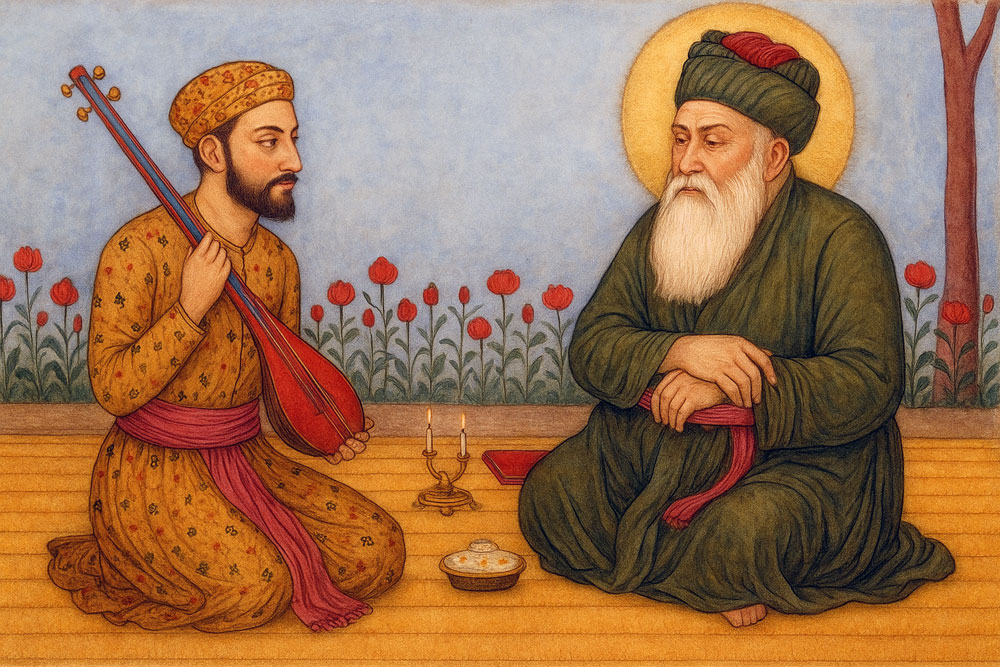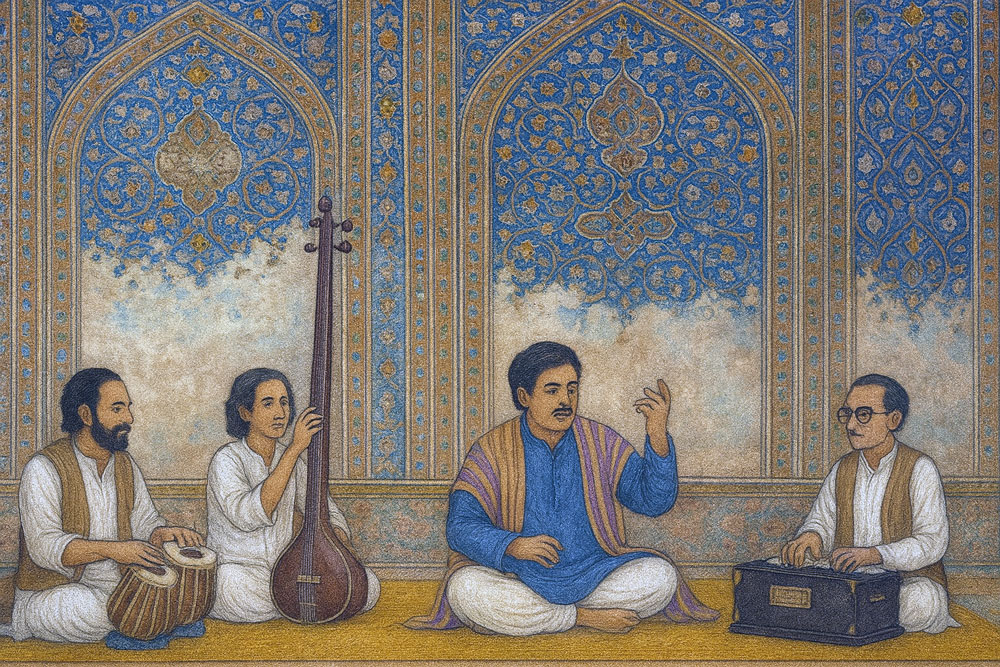
The Poet Between Two Homelands
Amir Khosrow Dehlavi, born in 1253 in the village of Patiyali in
present-day northern India, was a poet, musician, and mystic whose
life bridged cultures, languages, and traditions. His father, a Turkic
military officer, and his mother, of Rajput descent, gave him a unique
blend of Persian and Indian heritage. From an early age, Khosrow
received training in classical education: he mastered Persian, Arabic,
Turkish, and Hindi, while immersing himself in poetry, music, and
sciences. At just eight years old, he was spiritually drawn to the
Sufi master Nizamuddin Auliya (1),
whose influence would shape the course of his life. Amir Khosrow's
journey took him through the courts of the Delhi Sultanate
(2), where he served several
rulers, writing panegyrics (3) and
chronicles (4), while also
developing a deeply spiritual and creative legacy. He passed away in
1325, leaving behind a world that continued to echo with his voice. A
vast body of poetry remains from him—most of it in elegant and
expressive Persian. His verses often reflect the delicacy of love, the
fragrance of devotion, and the subtle play between presence and
concealment. As in this tender Ghazal
(5), where the beloved passes by:
Yesterday my beloved passed by the road, drunk and swaying,
So many settled hearts lost all their peace and possessions.
People recognized her by her fragrance, though she passed in
secret,
She exposed her seduction, though she walked discreetly.
I saw her face, radiant like the sun, so I applied perfume
Hoping she might stay.
She caught my scent, smiled sweetly, and passed happy and
enchanted, leaving me in despair.
Khosrow’s language, rich, refined, and musical would go on to shape
generations of Indo-Persian poets and mystics.
From Setar to Qawwali: His Musical Alchemy
Beyond poetry, Amir Khosrow’s most enduring contribution may be in the
realm of music. He is widely revered as the father of Qawwali
(6), the devotional musical form
that continues to stir hearts across South Asia. He introduced new
melodic structures and rhythmic patterns, blending Persian aesthetics
with Indian sounds. Though the invention of the Setar (long-necked
Persian lute) is still debated, legends credit him with refining it
from earlier lutes and shaping its musical voice—one that many believe
still carries his spirit. His impact on Indian music extends to the
popularization of vocal forms like Tarana
(7) and Khayāl
(8), as well as rhythmic
innovations. While traditional accounts often credit him with the
invention of the Tabla (9), modern
scholarship suggests the instrument likely evolved later from older
drums. Nonetheless, his role in transforming the sonic and devotional
landscape of the region is undisputed. Among his many spiritual
compositions, “Aaj Rang Hai” (meaning Today There is a Glow) remains a
luminous pillar of the Qawwali tradition, said to have emerged in
ecstatic celebration upon meeting his Sufi master, Nizamuddin Auliya.
Its words are both a declaration of divine love and a celebration of
spiritual arrival:
What a glow everywhere I see, Oh mother, what a glow;
I’ve found the beloved, yes I found him, in my courtyard;
I have found my Master, Nizamuddin Auliya.
I roamed around the entire world, looking for an ideal beloved;
And finally this face has enchanted my heart.
The whole world has been opened for me, never seen a glow like this
before.
Whenever I see now, he is with me,
Oh beloved, please dye me in yourself;
Dye me in the colour of the spring, beloved;
What a glow, Oh, what a glow.
Even centuries later, these verses continue to be sung in shrines,
gatherings, and concerts, reigniting the same spiritual fire Khosrow
first felt in the presence of his beloved guide. Aaj Rang Hai was
performed inimitably by many Qawwali singers such as Master Nusrat
Fateh Ali Khan
(10).
When the Soul Was Sung into the Body: A Rubāʿī in Song
Among Amir Khosrow’s many poems, one Rubāʿī
(11) stands out not only for its
spiritual intensity but also for the way it has lived on in voice and
breath. At the Samarkand Music Symposium 1979
(12), the legendary Afghan master
Ustād Mohammad Hussain Sarāhang
(13) performed this verse with a
depth that transcended time. Before singing, he recited the Rubāʿī
aloud, inviting the audience into a space of reflection.
"Pay attention," he says gently, more a guide than a performer,
as if opening a gate to something sacred:
On the creation day of Adam, the pure soul was called into the
body,
But it trembled, too afraid to enter the form.
Then angels sang with their divine tones:
“Enter the body! enter the form! come within, come in!“
It is in the final phrase "dar tan dar tan, darā darā andar tan!" that
something extraordinary unfolds. Sarāhang does not simply sing the
words; he transforms them into a musical invocation. Drawing on the
vocal tradition of Indian classical music, he lets the open vowels and
resonant syllables of the final phrase blossom into a meditative vocal
improvisation. The performance becomes both interpretation and
revelation—where the repetition of “dar tan” (into the body) is no
longer just a line of poetry, but a mantra, a breath, a vibration in
the room. The audience, quiet and alert, is carried into a soundscape
where Khosrow’s verse becomes a living presence, echoing as if sung by
the angels themselves. Listen to this unprecedented music performance.

Footnotes
(1) Nizamuddin Auliya – A
13th-century Indian Sufi saint of the Chishti Order, known for his
deep influence on the spiritual and cultural life of the Indian
subcontinent. Amir Khosrow was his devoted disciple.
go back
(2) Delhi Sultanate – A Muslim
kingdom that ruled large parts of India from 1206 to 1526, known for
its Persianized culture and Indo-Islamic synthesis in architecture,
administration, and arts.
go back
(3) Panegyrics – Formal poems of
praise written for kings and patrons, often used in courtly settings
to honor rulers.
go back
(4) Chronicles – Historical
accounts or narratives that document events over time, often with a
mix of factual and literary elements.
go back
(5) Ghazal – A poetic form
consisting of rhyming couplets and a refrain, expressing themes of
love, mysticism, and longing; deeply rooted in Persian and Urdu
literary traditions.go back
(6) Qawwali – A form of Sufi
devotional music popular in South Asia, characterized by emotional
intensity, rhythmic group clapping, and spiritual poetry.
go back
(7) Tarana – From Persian “ترانه,
meaning Song”, A vocal composition in Indian classical music to create
rhythmic and melodic texture, attributed in part to Amir Khosrow.
go back
(8)
Khayāl – From Persian “خیال, meaning Dream”, A major genre of
Hindustani classical vocal music, known for its improvisational
freedom and lyrical expressiveness.
go back
(9)
Tabla – A pair of hand drums central to Indian music; although
traditional accounts attribute its invention to Khosrow, many scholars
date its evolution to the 18th century.
go back
(10) Ustad Nusrat Fateh Ali Khan
– A Pakistani Qawwali singer who brought the genre to global
prominence in the 20th century with his powerful voice and
cross-cultural collaborations.
go back
(11) Rubāʿī – A Persian quatrain
with a specific meter, mostly known from 11th century Persian poet
Omar Khayyam, often used to express philosophical, mystical, or
existential insights in concise form.
go back
(12) Samarkand Music Symposium –
The First International Music Congress in Samarkand (1979), called
Sharq Taronalari ("Oriental Tunes"). Organized in the USSR, it
promoted intercultural dialogue on traditional eastern music and
creative integration.
go back
(13) Ustād Mohammad Hussain
Sarahāng – A renowned Afghan classical vocalist, well-known for his
masterful renditions of Persian poetry in the Dhrupad and Khayāl vocal
styles.
go back